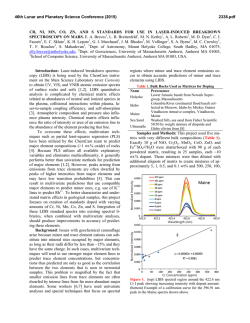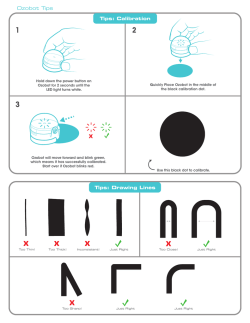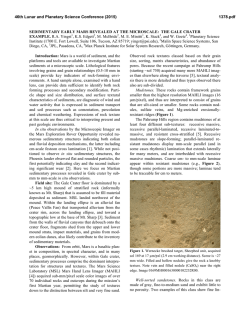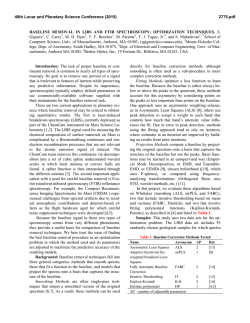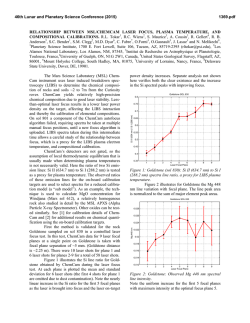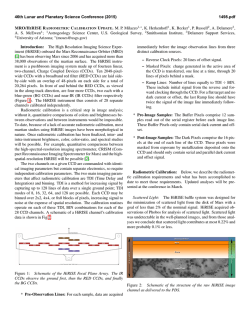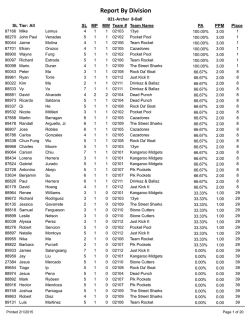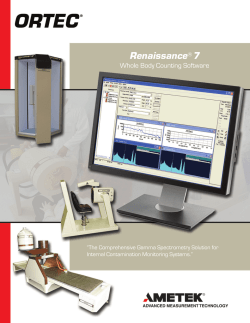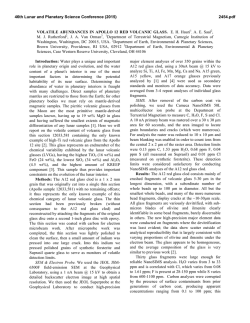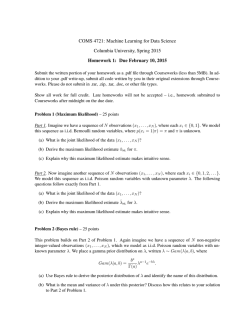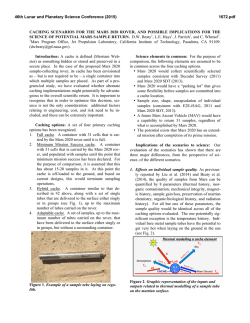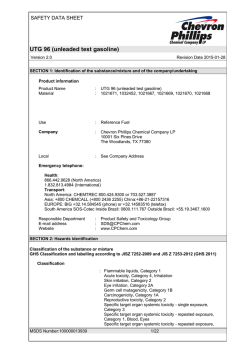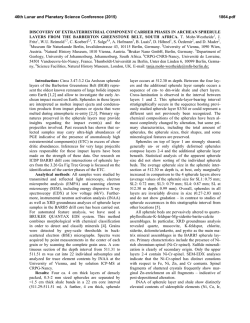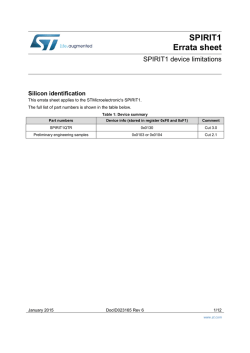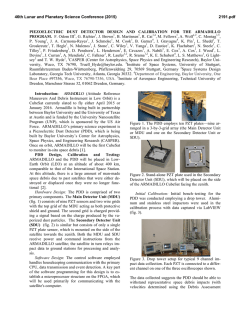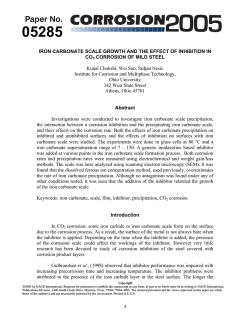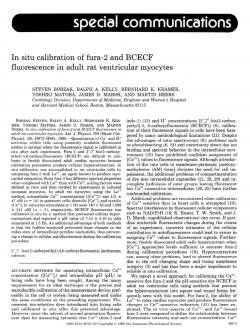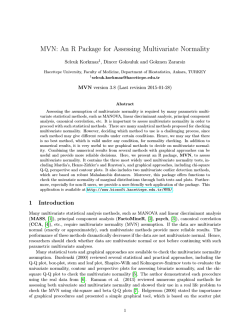
Nickel Calibration for Use in Laser
46th Lunar and Planetary Science Conference (2015) 2720.pdf NICKEL CALIBRATION FOR USE IN LASER-INDUCED BREAKDOWN SPECTROSCOPY ON MARS. K. H. Lepore1, T. F. Boucher2, E. A. Breves1, M. D. Dyar1, C. I. Fassett1, E. C. Sklute1, G. J. Marchand1, J. M. Rhodes3, M. Vollinger3, S. A. Byrne1, L. B. Breitenfeld1, M. N. Ketley1, M. C. Crowley1, A. L. Roberts3, S. Mahadevan2, 1Dept. of Astronomy, Mount Holyoke College, South Hadley, MA 01075, [email protected], 2 School of Computer Science, University of Massachusetts Amherst, Amherst MA 01003, 3Dept. of Geosciences, University of Massachusetts Amherst, Amherst MA 01003, USA. Introduction: The influx of iron and stony-iron meteorites and micrometeorites has enriched both Ni and Fe in soils and sedimentary rocks on terrestrial bodies. Although the Fe signal is obscured by its common occurrence, high Ni abundance can be used to measure meteoritic addition [1,2] and quantify the contribution from impacts. The ChemCam instrument on the Mars Science Laboratory rover Curiosity has the potential to quantify Ni abundances using laserinduced breakdown spectroscopy (LIBS) but a lack of standards for Ni has until now hampered assessment of the technique’s quantitative capabilities. This project focuses on creation of laboratory calibration standards and prediction models for determining Ni contents by LIBS. When applied to Mars data, the results will improve our understanding of the distribution of Ni in Martian soils and sedimentary rocks. Samples and Methods: The LIBS technique is known to be vulnerable to matrix effects, which permute the intensities and areas of emission peaks from specific elements so they are not directly correlated with elemental abundance. This problem complicates development of calibrations because each emission line manifests matrix effects in its own way. A calibration based on varying Ni concentrations in a single rock matrix may be useful only in rocks with that same matrix. Thus for broadest application to the variety of bulk compositions that might be encountered on Mars, a calibration for Ni must include rock matrices with varying chemistries spanning the ranges of the other nine major elements – essentially sampling a 10dimensional space. This project presents results from doping five different rock types to create a broadlyapplicable calibration for predicting Ni on Mars. Methods: Ten powders with varying Ni concentrations were prepared from each of the five matrices listed in Table 1, as described in more detail in [3]. Aliquots of each mixture were used for x-ray fluorescence analyses (XRF) of major and trace elements using standard protocols [4]; careful calculations of mass absorption coefficients are needed to produce good data for the higher-concentration standards. Because some of the rocks already contained some Ni (especially the ultramafic sample), the resultant samples had measured concentrations of 43,000-49,000, 7700-9995, 3700-5400, 750-2200, 285-1780, 141-1566, 58-1454, 36-1416, and 8-1400 ppm Ni. Samples were pressed Table 1. Univariate Model Results Line (nm) Holyoke Maine Sea Sand Idaho Ultramafic 5 channels 305.18 300.48 300.34 308.17 305.89 n.a. 10 -10,000 ppm RMSE R2 (ppm) 0.927 0.978 0.959 0.906 0.971 0.363 613 341 459 755 442 2175 10 -1000 ppm RMSE R2 (ppm) 0.000 0.557 0.173 0.000 0.610 0.017 189 134 188 217 238 605 into pellets and LIBS spectra were acquired in the Mineral Spectroscopy Laboratory at MHC [5] under a 7-Torr CO2 atmosphere using a wavelength range and power densities chosen to match those used by ChemCam on Mars. Calibration models were created using spectra of the doped samples as well as three of the ChemCam calibration targets [6] and 72 sedimentary samples provided by Scott McLennan for which Ni had previously been measured. Each spectrum was preprocessed to subtract a dark spectrum, resampled to standard wavelength increments, and corrected for the instrument response given the acquisition geometry. The Bremsstrahlung continuum was also removed. Univariate Analyses: In the doped samples only, channels in the range 300-310 nm have the highest correlation coefficients when their intensities are plotted vs. Ni concentration. All appropriate peaks were fit to Lorentzians and then Gaussians using a Matlab routine, but the results were unsatisfactory due to poor resolution and baseline issues. We also tried summing all channels in a peak and using the maximum intensity Figure 1. Comparison of Ni concentration predicted by a simple model using peak intensities of five Ni lines in five different matrices (Table 1) vs. Ni measured by XRF. 46th Lunar and Planetary Science Conference (2015) of each peak. All models reported here were tested using both un-normalized spectra and data normalized to spectrometer intensity in each of three wavelength regions. However, the best predictive models used normalized data, maximum peak intensity, and individual Ni I peaks at different energies for each matrix, as seen in Figure 1. Calibration curves in each individual matrix (Table 1) have root mean square prediction errors (RMSE) values ranging from 341-755 ppm when data from concentrations up to 10,000 ppm Ni are used and 134-238 ppm when only samples from 10-1000 ppm are included. These results suggest that a calibration curves developed on a single matrix will produce reasonable predictions when matched to the matrix of the unknown being predicted [7]. A calibration using all matrices and all five peaks combined yielded RMSE values of 2175 and 605 ppm Ni, showing that even a slightly-generalized calibration will not produce reliable quantitative results, as expected given the literature on matrix effects in LIBS [8,9]. Multivariate Analyses: Previous work has suggested that multivariate analysis techniques can mitigate matrix effects and reduce prediction errors [1012]. We undertook partial least squares analysis of various combinations of doped, sedimentary, and calibration target spectra as test and prediction sets, using cross-validation. These results are preliminary pending completion of analytical work on the compositions of the standards, and on development and testing of additional models. We do not yet have final quantitative results on the highest Ni samples, for which mass absorption coefficients are currently being calculated. Models (Table 2) are evaluated using three different metrics: 1) RMSE describing the difference between the model prediction and the true Ni concentration, 2) relative RMSE, which is the RMSE divided by the mean Ni concentration in the standards, and 3) R2 (coefficient of determination) of the best-fit line on a graph of predicted vs. measured Ni concentration. Viewed collectively on the basis of all three evaluation metrics, our results show that the model using all doped samples for which Ni analyses are available has a RMSE of 937 ppm Ni in the optimal and most general case. Better results can be obtained if the matrix of an unknown can be matched to that of one of the standards. For example, the RMSE for Ni in a matrix like that of the Idaho sample would have an error of ~400 ppm based on a model (A; see footnote to Table 2) with normalization to each of three spectrometers but no baseline removal was used. Our current data set of Ni in doped samples contains only 40 samples, but we will expand this to 210 samples over the coming months. Increasing the size of the training set should improve our generalizability and accuracy. We are also beginning to test how the addition of the other naturally-occurring sedimentary samples will 2720.pdf improve our accuracy for the multivariate approaches. Ni contents of McLennan’s samples are predominantly <1000 ppm, so when they are included in the training sets along with our doped sample, relative RMSE increases but total RMSE (i.e., the error bar on the measurement) decreases (improves). Multivariate analyses of those samples using Model C only suggest that RMSE’s <200 ppm will be possible in a generalized model for samples in that range of concentration. All Holyoke Maine Sea Sand Idaho Ultramafic Table 2. Multivariate Model Results Total Relative # Model R2 RMSE RMSE Comps A 937 0.48 0.88 10 B 979 0.51 0.87 10 C 1209 0.62 0.80 10 A 910 0.57 0.87 3 B 754 0.47 0.91 3 C 961 0.60 0.86 8 A 827 0.52 0.90 6 B 1179 0.74 0.79 10 C 1563 0.97 0.63 8 A 554 0.36 0.95 10 B 711 0.46 0.92 8 C 1743 1.13 0.53 5 A 405 0.23 0.98 4 B 707 0.40 0.93 4 C 705 0.40 0.94 7 A 889 0.28 0.91 3 B 754 0.24 0.93 4 C 1545 0.49 0.71 3 All spectra were masked to include only the following wavelength ranges: 298.827-302.788, 303.671-306.671, 308.745-311.745, 312.002-315,002, 331.784-334.784, 335.554-339.654, and 787.02792.78 nm. # Comps: optimal number of components used in the PLS model Model A: normalization to each of three spectrometers but no baseline removal Model B: no normalization and no baseline removal Model C: normalization to each of three spectrometers and baseline removal Conclusions: We are working toward acquisition of a broad, multi-matrix doped calibration set for measuring Ni on Mars. It is possible that we will have two different working models, one for higher-Ni samples and one for concentrations <~1,000 ppm. Results will inform the issue of meteoritic contamination of Martian surface materials. Acknowledgments: Supported by NASA MFRP grants NNX09AL21G, NNX12AK84G, and NNX14AG56G. References: [1] Yen A. S. et al. (2005) Nature, 436, 4954. [2] Yen A. S. et al. (2006) JGR, 111, E12S11. [3] Breves E. et al. (2015) this volume. [4] Rhodes J. M. (1988) JGR, 93, 4453-4466. [5] Dyar M. D. (2015) this volume. [6] Vaniman D. et al. (2012) Space Sci. Revs., DOI 10.1007/s11214-012-9886-0. [7] Byrne S. et al. (2015) this volume. [7] Lasue, J. et al. (2015) this volume. [8] Clegg S. M. et al. (2009) Spectrochim. Acta B, 64, 79-88. [9] Tucker J. M. et al. (2010) Chem. Geol., 277, 137-148. [10] Dyar M. D. et al. (2012) Spectrochim. Acta B, 70, 51-67. [11] Boucher T. F. et al. (2015) Spectrochim. Acta B, submitted. [12] Boucher T. (2015) J. Chemom., submitted.
© Copyright 2026
